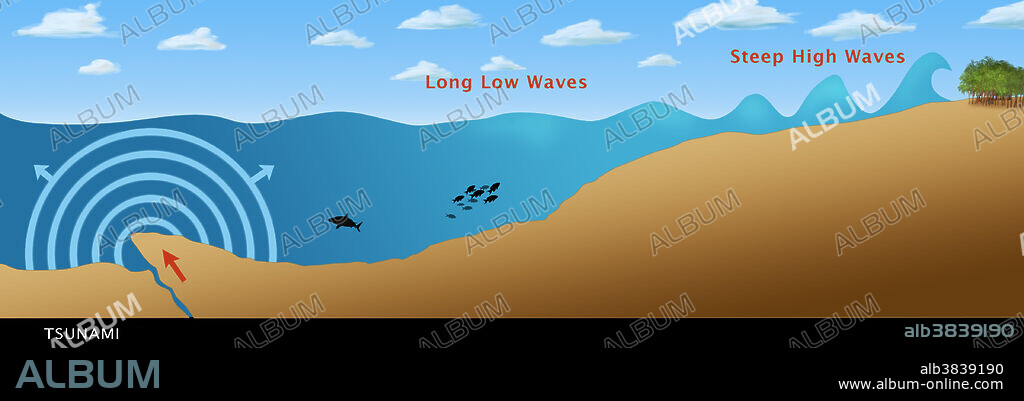alb3839190
Underwater Earthquake, illustration

|
Añadir a otro lightbox |
|
Añadir a otro lightbox |



¿Ya tienes cuenta? Iniciar sesión
¿No tienes cuenta? Regístrate
Compra esta imagen.
Selecciona el uso:

Título:
Underwater Earthquake, illustration
Descripción:
Ver traducción automática
Illustration of a tsunami formed from an earthquake (crack in the ocean floor), showing the variation in wavelength and height as the tsunami reaches shallow water. In the open ocean, tsunamis are very shallow with a very long wavelength, and can travel extremely fast, up to 1000 kilometres per hour. However, when the wave reaches shallower water, the waves are slowed and pile up, reducing the wavelength and increasing their height. Unlike normal waves, tsunamis do not break and then recede, the initial wave is followed by an enormous mass of water, which causes the majority of the damage. Tsunamis are caused by a displacement of the seabed, for instance by earthquakes, landslides or volcanic eruptions.
Crédito:
Album / Science Source / Monica Schroeder
Autorizaciones:
Modelo: No - Propiedad: No
¿Preguntas relacionadas con los derechos?
¿Preguntas relacionadas con los derechos?
Tamaño imagen:
4800 x 1632 px | 22.4 MB
Tamaño impresión:
40.6 x 13.8 cm | 16.0 x 5.4 in (300 dpi)
Palabras clave:
ALTURA • ANOTADO • ARBOLES • ARTE • BOSQUE • CIUDAD • CLIMA • COSTA • DESASTRE • DESTRUCTIVOS • DIAGRAMA • EDIFICIO • FALLO • FÍSICA (CIENCIA) • FLOTA • GEOLOGIA • GRÁFICOS • ILUSTRACION • INFOGRAFÍA • INFOGRAFÍAS • LITORAL • LONGITUD DE ONDA • MAR • MARINA • MARINE • NATURAL • OBRA DE ARTE • OCEANO • ONDA • PAISAJE • PAISAJES • PLANETA TIERRA • PLATO • PLAYA • SEA • SUELO • TIERRA (TERRENO) • TSUNAMI
 Pinterest
Pinterest Twitter
Twitter Facebook
Facebook Copiar enlace
Copiar enlace Email
Email
